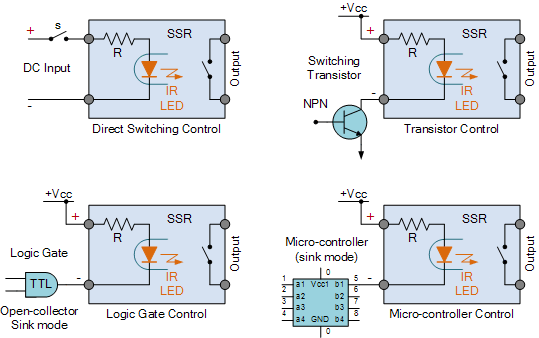
7 Reasons to Opt for Solid State Relays
SSRs offer a compelling alternative to traditional EMRs due to their numerous advantages. Their compact size, extended lifespan, low power consumption, fast switching speed, silent operation, minimal EMI noise, and suitability for harsh environments make them a versatile and reliable choice for various applications.
Relays are electrically operated switches that control high-power devices using low-power signals. They function by opening or closing contacts within a control circuit, indirectly affecting the load current. Control signals typically range from 3 to 32 volts DC. Additionally, relays offer protection against electrical abnormalities like overcurrent, undercurrent, overloads, and reverse currents, safeguarding equipment from damage.
Solid-state relays (SSRs) provide advantages in noise reduction, energy efficiency, and design simplicity over electromechanical relays (EMRs).
Relays are switches operated electrically to manage high-power devices through low-power signals. They govern a circuit by altering contacts in a control circuit, often without directly managing the load. Typical control signals range between 3 – 32 volts DC. Relays also safeguard systems by identifying electrical anomalies like overcurrent, undercurrent, overloads, and reverse currents, preventing equipment damage. Among the varieties of relays are machine control relays, reed relays, electromechanical relays (EMRs), and solid-state relays (SSRs). This article delves into the distinctions among these relay types, highlighting seven compelling reasons for choosing SSRs.
Types of Relays
Machine control relays: These heavy-duty relays, operated by a magnetic coil, are commonly used for controlling starters and industrial components. While durable, they tend to be more expensive than general-purpose relays.
Reed relays: Featuring a fast-operating switch with a normally open contact, reed relays are hermetically sealed in glass, protecting their contacts from contaminants and ensuring reliable switching.
Electromechanical relays (EMRs): These robust relays utilize magnetic force to operate contacts. While affordable and easy to replace, their larger size and slower operation make them less suitable for some applications. Additionally, their moving parts contribute to a shorter lifespan.
Solid-State Relays: SSRs are increasingly preferred in general-purpose applications, offering fully electronic switching without mechanical contacts. They utilize electronic components like silicon-controlled rectifiers for current switching. SSRs are notable for their electrical isolation between input and output, low and high resistance when off and conducting respectively, and capability to manage both AC and DC currents. They consume less power and switch faster than EMRs.
SSR Configuration
An SSR comprises an input circuit, a control circuit, and an output circuit. The input circuit functions similarly to EMRs' coil, activating at voltages above the specified level and deactivating below it. The control circuit mediates between the input and output, determining the output's activation or deactivation. SSRs typically feature a single output contact.
The Rise of Solid State Relays (SSRs)
SSRs are electronic switching devices that lack moving contacts. Instead, they employ components like silicon-controlled rectifiers (SCRs), triodes for alternating current (TRIACs), or switching transistors to achieve electronic current switching. Notably, SSRs provide complete electrical isolation between input and output circuits. When turned off, they exhibit very high resistance, and conversely, very low resistance when conducting. They can handle both AC and DC currents with a wide range depending on the application, from microamps to hundreds of amps. Additionally, their control signal input circuit consumes less power compared to EMRs, and their switching time is significantly faster.
Seven key advantages of SSRs over EMRs:
Design Simplicity: SSRs boast a smaller footprint and lighter weight compared to EMRs of similar specifications. This compactness makes them ideal for embedded systems where space is a premium. Additionally, SSRs operate in any position (vertical or horizontal) and offer complete circuit isolation through optical coupling, eliminating high-voltage failure risks.
Extended Lifespan: The absence of moving parts eliminates concerns about arcing or wear and tear in SSRs. Consequently, their lifespan is significantly longer than EMRs, making them ideal for applications requiring frequent operation.
Reduced Power Consumption: Since SSRs lack bulky coils and moving contacts, they require considerably less power to operate compared to EMRs. Their input power is minimal, only enough to drive a low-energy LED within an optical coupler.
Faster Switching Speed: SSRs offer much faster switching due to the lack of physical parts to move. Their switching time depends on the LED's response to the control signal, which is nearly instantaneous (less than 100 microseconds). In contrast, EMRs have an average switching time ranging from 5 to 15 milliseconds.
Silent Operation: The electronic switching mechanism of SSRs results in completely silent operation, a valuable feature in various commercial and medical applications.
Minimal EMI Noise: Low-noise SSRs provide both zero-voltage turn-on and zero-current turn-off, significantly reducing electromagnetic interference (EMI) noise. This zero-crossover switching eliminates arcing and electrical noise associated with switching AC loads. Additionally, SSRs prevent switching off the load during a sine wave peak, crucial for inductive loads to avoid large voltage spikes.
Suitability for Harsh Environments: Industrial environments often present challenges like extreme temperatures, dust, humidity, vibrations, and mechanical stress. The enclosed design and lack of moving parts in SSRs make them well-suited for these harsh conditions. Furthermore, SSR operation doesn't generate sparks, allowing safe use in combustible environments. They are also minimally affected by external magnetic fields.